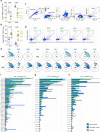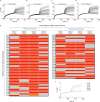Antibody feedback regulates immune memory after SARS-CoV-2 mRNA vaccination
- PMID: 36473496
- PMCID: PMC9876794
- DOI: 10.1038/s41586-022-05609-w
Antibody feedback regulates immune memory after SARS-CoV-2 mRNA vaccination
Abstract
Feedback inhibition of humoral immunity by antibodies was first documented in 19091. Subsequent studies showed that, depending on the context, antibodies can enhance or inhibit immune responses2,3. However, little is known about how pre-existing antibodies influence the development of memory B cells. Here we examined the memory B cell response in individuals who received two high-affinity anti-SARS-CoV-2 monoclonal antibodies and subsequently two doses of an mRNA vaccine4-8. We found that the recipients of the monoclonal antibodies produced antigen-binding and neutralizing titres that were only fractionally lower compared than in control individuals. However, the memory B cells of the individuals who received the monoclonal antibodies differed from those of control individuals in that they predominantly expressed low-affinity IgM antibodies that carried small numbers of somatic mutations and showed altered receptor binding domain (RBD) target specificity, consistent with epitope masking. Moreover, only 1 out of 77 anti-RBD memory antibodies tested neutralized the virus. The mechanism underlying these findings was examined in experiments in mice that showed that germinal centres formed in the presence of the same antibodies were dominated by low-affinity B cells. Our results indicate that pre-existing high-affinity antibodies bias germinal centre and memory B cell selection through two distinct mechanisms: (1) by lowering the activation threshold for B cells, thereby permitting abundant lower-affinity clones to participate in the immune response; and (2) through direct masking of their cognate epitopes. This may in part explain the shifting target profile of memory antibodies elicited by booster vaccinations9.
© 2022. The Author(s).
Conflict of interest statement
The Rockefeller University has filed a provisional patent application in connection with this work, on which M.C.N. is listed as an inventor (US patent 63/021,387). The patent has been licensed by Rockefeller University to Bristol Meyers Squib. P.D.B. has received remuneration from Pfizer for consulting services related to SARS-CoV-2 vaccines.
Figures











Update of
-
Antibody feedback regulation of memory B cell development in SARS-CoV-2 mRNA vaccination.medRxiv [Preprint]. 2022 Aug 10:2022.08.05.22278483. doi: 10.1101/2022.08.05.22278483. medRxiv. 2022. Update in: Nature. 2023 Jan;613(7945):735-742. doi: 10.1038/s41586-022-05609-w. PMID: 35982682 Free PMC article. Updated. Preprint.
References
Publication types
MeSH terms
Substances
Grants and funding
LinkOut - more resources
Full Text Sources
Other Literature Sources
Medical
Miscellaneous

